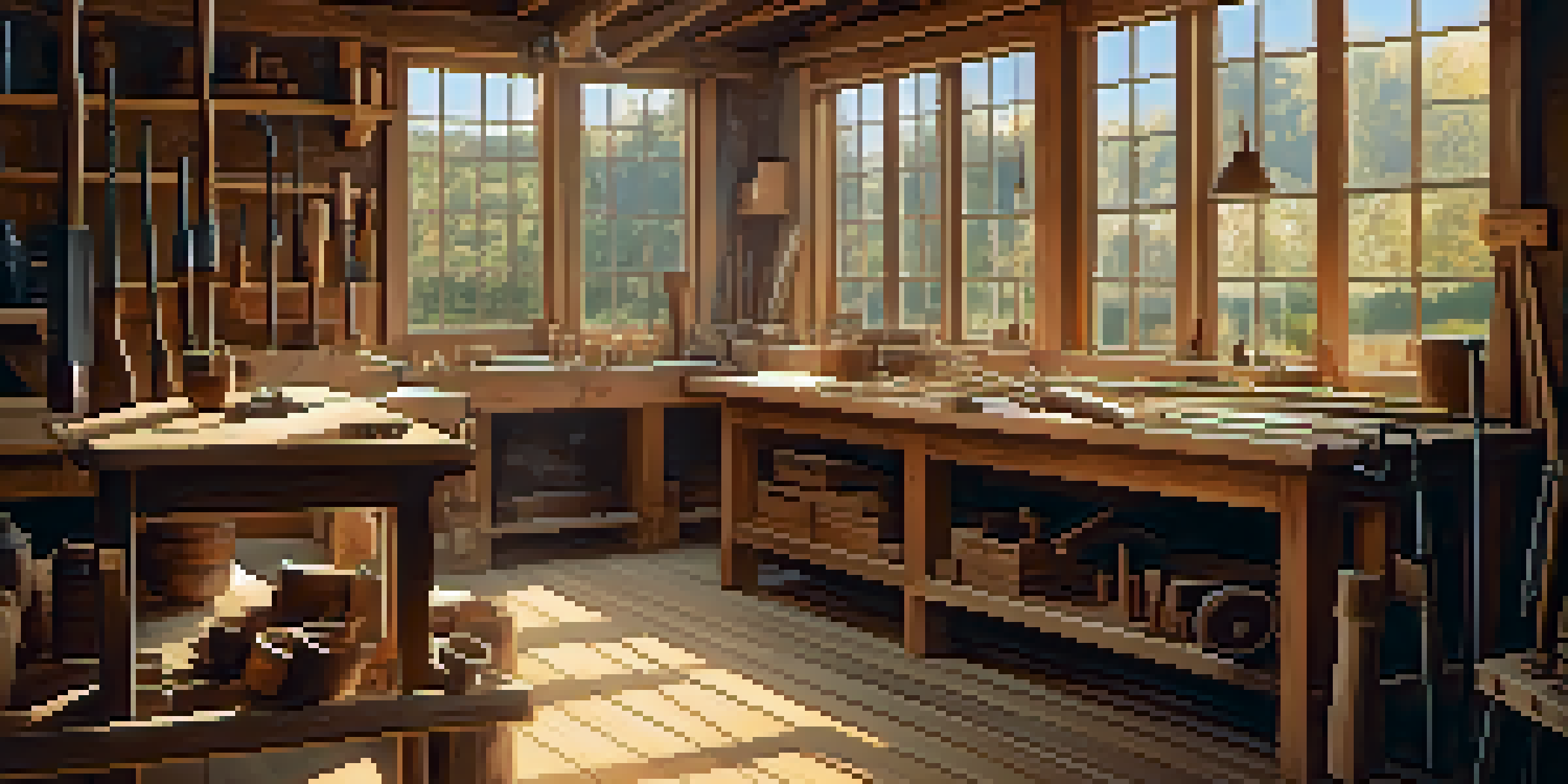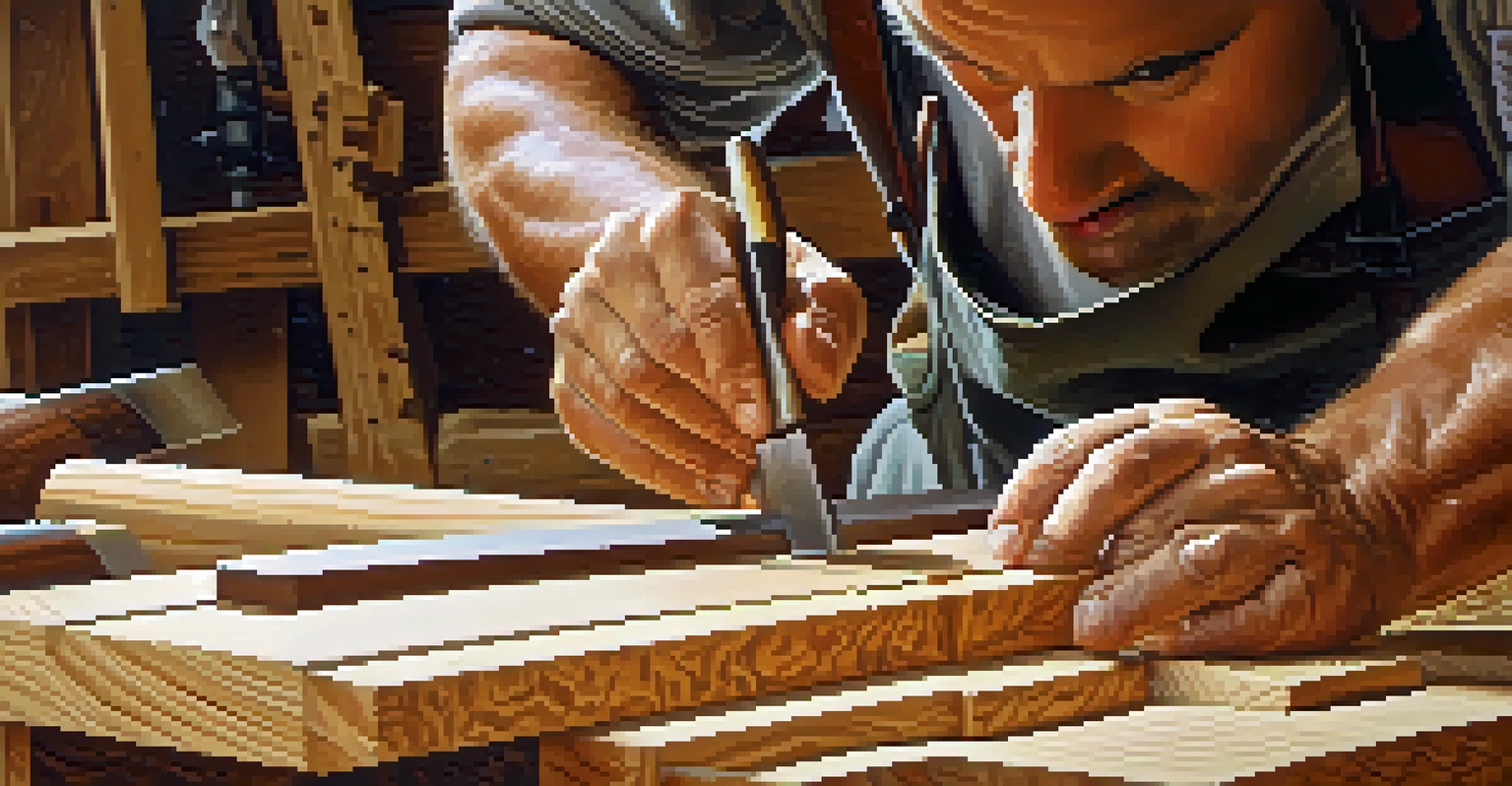Traditional Woodworking Methods: Preserving Age-Old Techniques

The Importance of Traditional Woodworking Techniques
Traditional woodworking techniques are more than just skills; they represent a connection to our history and culture. These methods have been passed down through generations, embodying the craftsmanship and artistry of our ancestors. By preserving these techniques, we not only honor their legacy but also continue to learn from their expertise.
Woodworking is a craft, and a craft is a way of life, not just a means to an end.
In today’s fast-paced world, where mass production often overshadows artistry, these age-old methods remind us of the value of patience and precision. Each cut and joint in traditional woodworking tells a story of dedication and love for the craft, creating unique pieces that are often one-of-a-kind. This personal touch is something that machine-made products simply cannot replicate.
Moreover, embracing traditional woodworking can have environmental benefits as well. By using locally sourced materials and time-tested methods, woodworkers can minimize waste and promote sustainability. This approach not only preserves the craft but also encourages a greater appreciation for the resources we use.
Key Tools Used in Traditional Woodworking
Traditional woodworking relies heavily on a set of hand tools that have stood the test of time. Tools like chisels, hand saws, and planes allow artisans to shape wood with incredible precision. Unlike modern power tools, these hand tools require a deep understanding of technique and control, making each piece a testament to the craftsman's skill.

For example, a chisel can be used in various ways—from carving intricate designs to creating joints that fit perfectly. This versatility is a hallmark of traditional woodworking, encouraging creativity and innovation within established methods. Each tool has its own significance, often with a rich history that adds depth to the craft.
Traditional Techniques Preserve History
Embracing traditional woodworking techniques honors our cultural heritage and fosters a deeper appreciation for craftsmanship.
Additionally, the use of hand tools fosters a deeper connection between the woodworker and the material. The tactile experience of shaping wood by hand can be incredibly satisfying, allowing artisans to feel the grain and the character of the wood. This hands-on approach not only enhances the final product but also imbues it with a sense of soul.
Mastering Joinery: The Heart of Traditional Woodworking
Joinery is often considered the heart of traditional woodworking, as it involves the techniques used to connect pieces of wood together seamlessly. Techniques like dovetail joints, mortise and tenon, and lap joints are not just functional; they also showcase the skill and artistry of the woodworker. Each type of joint serves a specific purpose and can add unique beauty to a project.
The best wood is the wood that you have. It is what you do with it that counts.
Take, for instance, the dovetail joint, known for its strength and aesthetic appeal. Often used in drawer construction, the interlocking shape of the joints creates a visual feast while ensuring durability. Mastering such techniques takes time and practice, highlighting the dedication required to excel in this craft.
Furthermore, the choice of joinery can greatly influence the overall design and functionality of a piece. By understanding the principles behind each joint, woodworkers can create furniture that not only looks great but also stands the test of time. This deep knowledge is what keeps traditional woodworking vibrant and relevant today.
The Role of Wood Selection in Craftsmanship
Choosing the right type of wood is a crucial step in traditional woodworking. Different species offer varied characteristics, from grain patterns to hardness, influencing both the aesthetics and the performance of the final product. For example, oak is prized for its durability and beautiful grain, making it a popular choice for furniture.
Understanding the properties of different woods allows artisans to select materials that best suit their intended design. This knowledge is often gained through experience, as woodworkers learn how each type behaves during the crafting process. The right selection can mean the difference between a project that lasts for generations and one that falls short.
Joinery Defines Woodworking Artistry
Mastering joinery techniques is crucial, as it showcases the skill of the woodworker and enhances the beauty and functionality of the piece.
Additionally, sourcing wood sustainably has become increasingly important in modern woodworking. By opting for reclaimed or locally sourced timber, artisans can reduce their environmental impact while still honoring traditional methods. This mindful approach not only preserves the craft but also promotes a healthier planet.
Finishing Techniques: Enhancing the Beauty of Wood
Finishing techniques are essential in traditional woodworking, as they protect the wood and enhance its natural beauty. From oils and varnishes to waxes, each finishing method plays a crucial role in preserving the integrity of the wood while showcasing its unique grain. For instance, an oil finish can deepen the color while providing a soft sheen that highlights the wood's character.
Moreover, the process of finishing is often seen as an art in itself. Woodworkers must understand how different finishes interact with various types of wood, making careful choices that align with their vision for the piece. This step is where the craftsmanship truly shines, transforming a raw, unfinished item into a stunning work of art.
Additionally, the choice of finish can impact the piece's longevity. A well-applied finish not only enhances aesthetics but also protects against moisture, wear, and UV damage. This attention to detail ensures that traditional woodworking pieces are not only beautiful but also built to last.
Teaching and Learning Traditional Woodworking
Passing down traditional woodworking techniques is essential for keeping the craft alive. Many woodworkers today learn through apprenticeships, where they are mentored by seasoned artisans. This hands-on experience is invaluable, allowing students to absorb knowledge and skills that cannot be found in books or online tutorials.
Workshops and community classes are also becoming popular avenues for sharing traditional woodworking. These gatherings foster a sense of community, where enthusiasts of all skill levels can learn from each other. Participants often leave with not only new skills but also a deeper appreciation for the craftsmanship involved.
Sustainable Wood Choices Matter
Selecting the right type of wood and sourcing it sustainably is essential for both the quality of the project and the health of the environment.
Furthermore, the resurgence of interest in handmade goods has sparked a renewed focus on teaching these techniques. As more people seek to create meaningful, handcrafted items, the demand for traditional woodworking knowledge has grown. This shift not only preserves the craft but also inspires a new generation of artisans.
The Future of Traditional Woodworking in a Modern World
As technology advances, one might wonder about the future of traditional woodworking methods. While modern tools and techniques offer incredible efficiency, the essence of traditional craftsmanship remains irreplaceable. Many artisans are finding ways to blend the old with the new, using technology to enhance their work while still honoring age-old practices.
For instance, some woodworkers use computer-aided design (CAD) software to plan intricate designs, which they then execute using hand tools. This fusion allows for precision while maintaining the personal touch that defines traditional woodworking. It’s a beautiful harmony between innovation and heritage.

Ultimately, the future of traditional woodworking lies in the hands of passionate artisans who value the craft. As long as there are those willing to learn, teach, and create, these age-old techniques will continue to thrive. The journey of woodworking is not just about making furniture; it’s about preserving a legacy and nurturing a connection to our past.